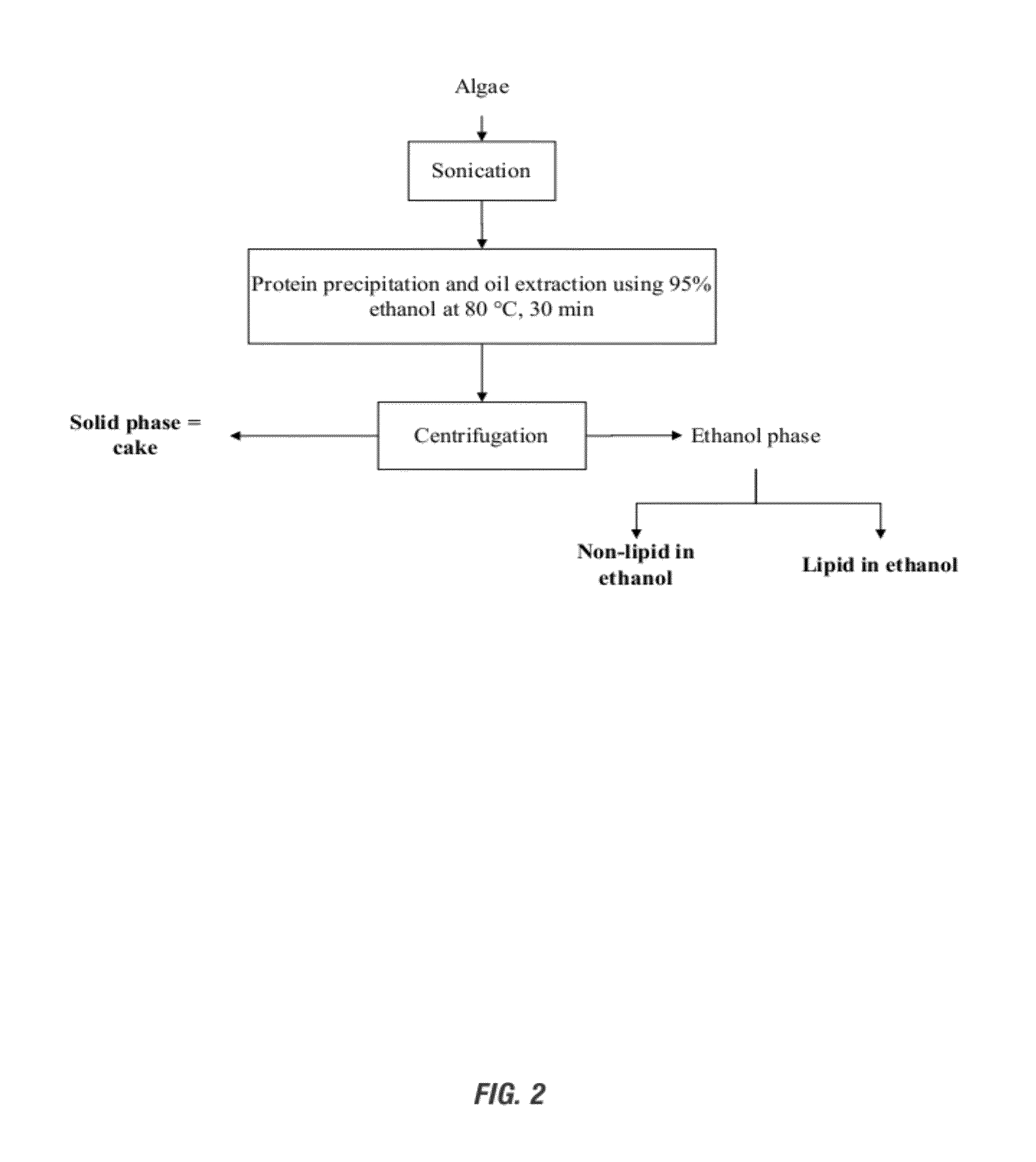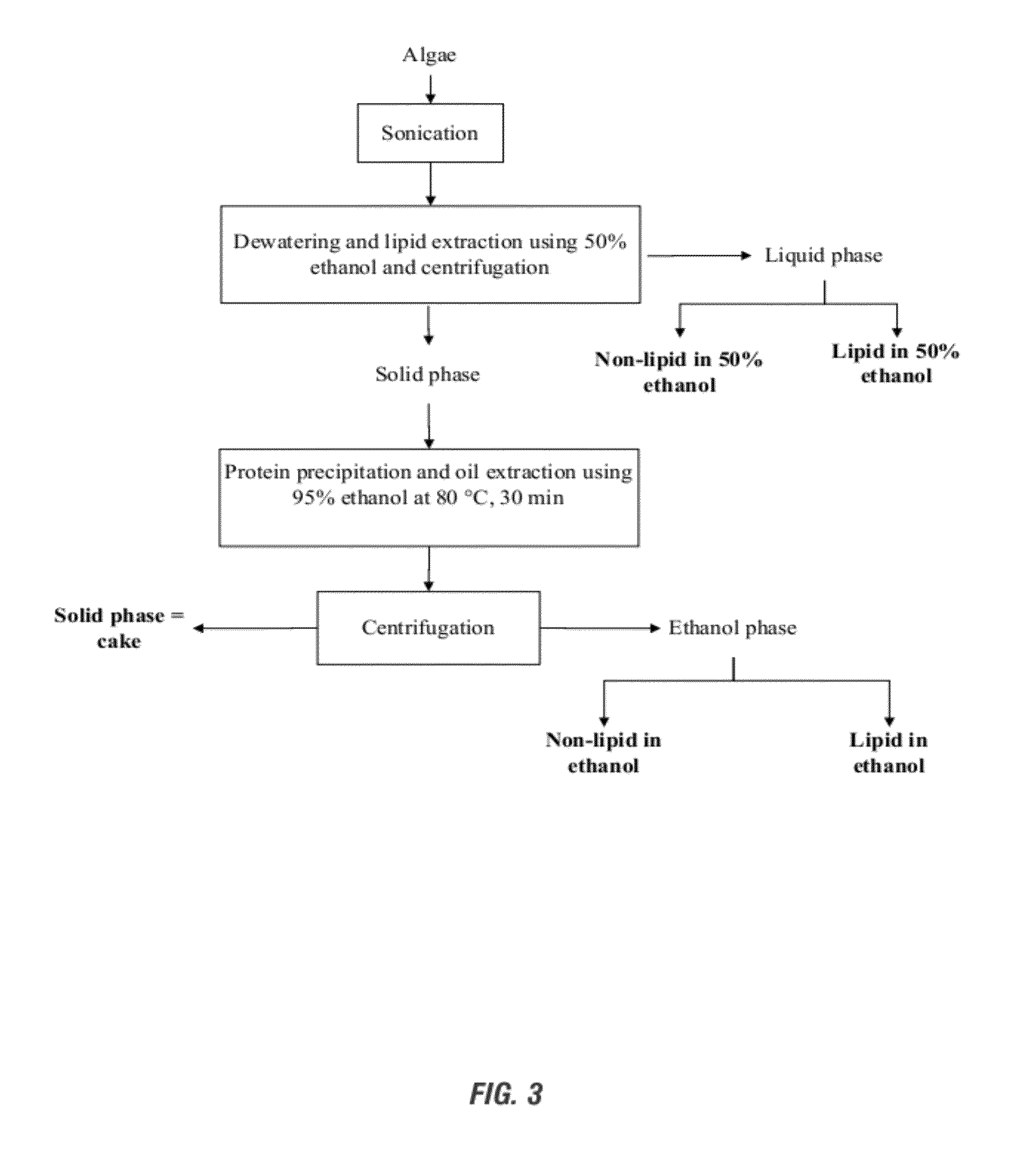Oil extraction from microalgae
a technology of algae oil and microalgae, which is applied in the field of lipid and biomass recovery of microalgae, can solve the problems of unsuitable industrial algae oil extraction, ineffective algae oil extraction, and cell breakage, and achieve the effect of cost and energy consumption
- Summary
- Abstract
- Description
- Claims
- Application Information
AI Technical Summary
Benefits of technology
Problems solved by technology
Method used
Image
Examples
example 1
[0055]An objective of experimentation according to the invention was to fully extract lipids from oleaginous microalgae. In particular, a further objective was to determine lipid and biomass distribution during aqueous and alcohol processing of oleaginous microalgae, with the intention of fully extracting lipid from the dewatered cell paste. Two species, Nannochloropsis and Schizochytrium were used in our aqueous and alcohol processing systems. The distribution of lipids and non-lipid components, i.e. biomass, during aqueous process and ethyl alcohol process were investigated. It was shown that majority of the lipids, 73% in Nannochloropsis and 87% in Schizochytrium were held by the broken cell mass in the centrifugation solids by aqueous processing. This retention of the lipid by the cell solids obtained by centrifugation demonstrates the need for developing a more effective lipid extraction method.
[0056]As shown in the results below, the use of an alcohol—ethanol—under elevated te...
example 2
[0085]Study of Lipid and Non-Lipid Biomass Distribution During AEP. Lipid Distribution During AEP:
[0086]As shown in FIG. 1, the lipid recovery from the aqueous phases during AEP processing is the sum of Lipid 1 and Lipid 2 fractions, which were the lipids partitioned in water. Lipid 3, 4, and cake oil fractions were the lipids that were trapped in the solids and had to be extracted by solvents with increasing polarity.
TABLE 2Lipid (% of total) distribution through AEP processingNannochloropsisSchizochytriumFraction\Sonication / Sonication / treatmentEnzymeEnzymeEnzymeEnzymeLipid 117.5 ± 10.915.2 ± 13.2 6.7 ± 5.9 5.9 ± 1.7Lipid 2 8.7 ± 4.211.4 ± 4.8 5.9 ± 3.4 7.3 ± 6.3Lipid 3 3.4 ± 2.7 9.3 ± 2.819.8 ± 5.925.9 ± 0.3Lipid 419.5 ± 6.422.6 ± 2.1 9.1 ± 6.3 4.8 ± 1.2Cake Oil35.4 ± 6.224.6 ± 2.618.9 ± 10.036.9 ± 7.0Total Lipid 84.4 ± 9.283.1 ± 10.560.4 ± 0.3b80.9 ± 13.1aRecoveryMeans for each species within each row are not significant except for total recovery from Schizochytrium at P = 0.05.
[...
example 3
[0096]Lipid Extraction with Ethyl Alcohol in Aqueous System. Lipid Recovery from Nannochloropsis by One-Step ESP Processing:
[0097]The lipid amount in Lipid fraction (FIG. 2) accounted for almost a full lipid recovery (96.4%, 5 g-scale in FIG. 5), which indicates hot ethanol treatment is a very effective extraction approach for sonicated algae samples. A scale-up procedure with 50 g of Nannochloropsis resulted in a lipid recovery of 68.3%, a value much lower than that of 5 g-scale. This is possibly due to the fact that larger amount of algal cells made sonication treatment difficult and insufficient to break all cells. Many sonication parameters can be optimized, and our current on-going research is focused on the study of sonication energy input needed for various cell types, cell density, and sample volume.
[0098]A further investigation examining the residual oil in both cake fraction and fractionated non-lipid fraction in ethanol extract revealed the lipid distribution of Nannochlo...
PUM
| Property | Measurement | Unit |
|---|---|---|
| temperature | aaaaa | aaaaa |
| temperature | aaaaa | aaaaa |
| concentration | aaaaa | aaaaa |
Abstract
Description
Claims
Application Information
 Login to View More
Login to View More - R&D
- Intellectual Property
- Life Sciences
- Materials
- Tech Scout
- Unparalleled Data Quality
- Higher Quality Content
- 60% Fewer Hallucinations
Browse by: Latest US Patents, China's latest patents, Technical Efficacy Thesaurus, Application Domain, Technology Topic, Popular Technical Reports.
© 2025 PatSnap. All rights reserved.Legal|Privacy policy|Modern Slavery Act Transparency Statement|Sitemap|About US| Contact US: help@patsnap.com



